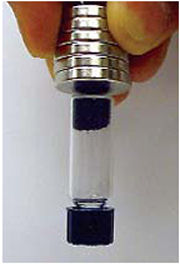- More than 2 years ago
A new family of magnets may be a first step toward organic versions of the familiar metal objects, researchers say.

Fabricating metal magnets requires high temperatures, notes Robin G. Hicks, a chemist at the University of Victoria in British Columbia. With organic substitutes, it may be possible to mix up magnets in a room-temperature solution and easily mold them into films or other shapes that could find new uses, he says.
Hicks and his colleagues describe in the Jan. 18 Nature three metal-organic magnets. To create them, the researchers mixed a nickel-containing chemical into solutions of organic compounds. They then stirred each mixture for several hours at room temperature, exposing the mixtures to air only during the last half of the process.
After this two-stage chemical reaction, the researchers filtered out dark, powdery solids combining the organic materials with nickel and oxygen.
Team members held magnets to the sides of the flasks as a first test of success or failure. “It’s easy to tell if you’ve made a magnet,” says Hicks.
Further tests revealed that the organic substances remained magnetic at temperatures up to 200°C and suggested that they could be easily demagnetized, a valuable trait in some applications. The researchers are now determining the chemical structure of the molecules that they created.
This first group of organic magnets is not moldable, but the team expects that trait to be attainable. “Using organic chemistry to control the structure of the organic molecules in turn provides a handle for controlling the structure and the properties of the magnet you make,” Hicks says.






